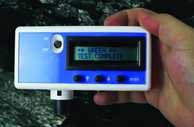Mining Feature: Technology for Real-Time Monitoring of Coal Dust Explosion Hazards
Monday, December 05, 2011
Updated on October 1, 2012
The Coal Dust Explosibility Meter (CDEM), described below, was the "People's Choice" Award 2012 winner in the HHSinnovates program. Over 14,000 votes were cast by the public to select the People's Choice winner. Votes were cast for six finalists chosen by employees from the Department of Health & Human Services (HHS) as the most innovative achievements in 2012 by government employees. From those six finalists, in addition to being the People's Choice winner, the CDEM was selected by HHS Secretary Sebelius as one of three "Secretary's Top Picks."
The NIOSH-developed Coal Dust Explosibility Meter is a handheld device that determines the explosibility of rock and coal dust mixtures in real time. A recently published NIOSH Information Circular, “Coal Dust Explosibility Meter Evaluation and Recommendations for Application,” details an investigation of the CDEM’s ability to accurately predict the explosibility of coal and rock dust mixtures in underground mines. The conclusions strongly support using the CDEM in the field to measure explosibility and improve onsite rock dusting. The CDEM is available now for purchase and use in underground coal mines.
The new Mine Safety and Health Administration (MSHA) rule requires a minimum of 80% rock dust in all mined areas outside the return airway to prevent explosion propagation. Both the CDEM and the new MSHA rule represent the significant impact that the NIOSH Office of Mine Safety and Health Research (OMSHR) has on the mining industry.
Mine explosions remain a threat to underground coal mine workers, requiring constant vigilance to prevent accumulations of combustible gasses and dusts. Accumulations of combustible dust in coal mines create the risk of large-scale explosions that can result in multiple deaths and traumatic injuries. The explosion hazard can be effectively controlled through the application of rock dust, such as limestone dust, to render inert the combustible coal dust generated during the mining and transport of coal. Traditionally, determining when additional rock dust should be applied or evaluating the effectiveness of existing rock dust application has been limited to a subjective visual evaluation or collection and laboratory analysis of dust samples—a process that requires days or weeks to identify a hazard.
For decades, mine workers have been able to monitor the concentrations of methane and other combustible gasses using handheld, direct reading gas detectors. These detectors allow mine workers and mine operators to take immediate action to dilute gasses and prevent explosions. With this same purpose in mind, OMSHR researchers developed the CDEM to provide instant feedback on the relative hazard of dust accumulations in the mine and the effectiveness of the mine's rock dusting practices. This simple-to-use handheld device provides a pass/fail assessment of coal mine dust samples, allowing for immediate action by operators or regulators to eliminate an explosion hazard.
Development of the CDEM required significant research by OMSHR and its predecessor program in the U.S. Bureau of Mines, in collaboration with MSHA, to identify a technology that could provide real-time results comparable to the existing laboratory test. Researchers then transferred the technology—which received the R&D 100 Award in 2006 for Innovation in Technology—from the lab setting to the field, and refined the device to pass the rigorous MSHA evaluation for intrinsic electrical safety. Sensidyne Industrial Health and Safety Instrumentation recently commercialized the meter.
MSHA related content
NIOSH OMSHR links related to Coal Dust Explosion Hazards
See Also
- Coal Dust Explosibility
- Coal Dust Explosibility Meter Evaluation and Recommendations for Application
- Field Evaluation of the Coal Dust Explosibility Meter
- How Does Limestone Rock Dust Prevent Coal Dust Explosions in Coal Mines?
- How to use the Coal Dust Explosibility Meter
- Mitigating Coal Dust Explosions in Modern Underground Coal Mines
- Recommendations for a New Rock Dusting Standard to Prevent Coal Dust Explosions in Intake Airways
- Rock Dusting
- Rock Dusting Considerations in Underground Coal Mines
- Technology News 515 - Float Coal Dust Explosion Hazards
- Page last reviewed: 10/1/2012
- Page last updated: 10/1/2012
- Content source: National Institute for Occupational Safety and Health, Mining Program


 ShareCompartir
ShareCompartir
